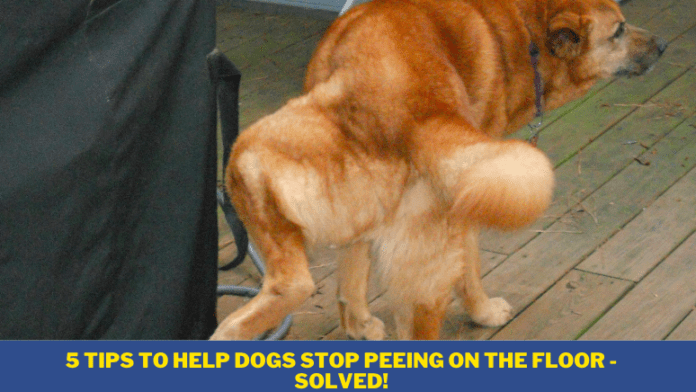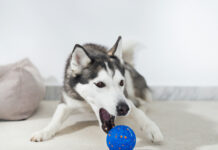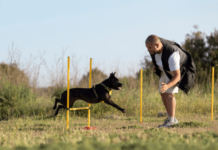Last Updated on January 9, 2022 by Dogs Vets
How to Teach Your Dog to Avoid House Peeing
This article gave guidelines on how to manage your dog’s behaviour and make them understand what they can and cannot do in the house, such as peeing in certain places or not being allowed outside when they need to go potty.
Introduction
Bringing a new puppy home is a lot of fun! However, the first several weeks can be rather trying. Both you and your pooch must adjust to life together.
For the majority of puppies, this entails figuring out where they should – and should not – pee!
If your house begins to smell like a kennel, you’ll quickly lose the rose-coloured glasses of puppyhood. Certain dogs simply do not understand where they are meant to “go.” Others are dusting their signature perfume on various belongings in an attempt to claim them.
In either case, you’re going to want your dog to avoid peeing in your house.
Why do dogs pee in the house?
Dogs are known to be great companions for humans. They are loyal, friendly and always happy. But, dogs also have a habit of peeing in the house, which can create some problems especially if you have a small child.
In most cases when the dog pees inside the house, it is because they feel insecure and vulnerable in their own territory. This means that they don’t feel like there is any danger outside of their house and want to protect themselves from any possible threat by peeing in the house before entering it again.
Poodles are determined and intelligent dogs that can also be stubborn at times. They are a challenge for pet owners because they often make mistakes such as peeing inside the house or pooping. Owners must be careful when training poodles.
In order to keep your house clean, it’s not just about cleaning your house.
You should also train your dog to not pee in the house.
In order not to teach your dog bad habits, it is important for owners to be consistent with training methods in order for them to stick with them.
There are a few steps you can take to train your dog not to pee on the floor. Some of these steps include:
-Teaching your dog “No” or “Out”
-Working on their recall method by using a treat or toy and then taking it away when they start to pee.
-Giving them plenty of exercises.
5 Tips to Help Dogs Stop Peeing on the floor
There are a few things you can do to make your dog stop peeing on the floor and keep their paws clean.
-1., make sure they have plenty of clean, dry pee pads available: Placing them in strategic locations around the house can help prevent a lot of accidents.
-2., If your dog has strong pheromones that make them feel safe and secure, reduce their exposure to other dogs and places where they might get into trouble.
-3., Teach your dog to not go to one specific place: because it is “their spot” – but limit the times they are allowed to go there or just take them there for a quick potty break every so often.
-4, It is important for you to teach your dog what is and is not okay for them: This will help them to avoid chewing up expensive or breakable items or causing a mess around the house. It will also help you to teach him or her that certain actions are not acceptable in your home.
5. Put on a pair of rubber gloves: Put on gloves to keep the smell off your hands and make the areas you are cleaning more effective.
How to Train Your Dog to Stop Peeing on the Floor
The article gives dog owners tips on how to train their dogs to stop peeing on the floor. It also informs that there are many factors that may influence your dog’s behaviour in this regard.
The article started by giving an example of a dog that pees outside the house by using a litter box. This is because it was taught to do so when it was young. To address this issue, the owner should start with creating a positive association with peeing indoors.
5 Ways to Teach Your Dog Not To Pee On Anything Else – From Furniture To Carpets
The concept of the peeing dog has been around for centuries. Dogs that don’t know how to use a toilet can experience health problems like urinary tract infections and bladder stones. It’s important to teach your dog when, where, and how to eliminate outside.
When training your dog not to pee on things, you have to be firm and consistent in the process. Here are some ways you can teach your dog not to pee on furniture, carpets and rugs:
– Make sure your dog is fully house trained.
– Keep your home clean by removing any items that have been peed on.
– Give your dog a place to relieve itself outside in an enclosed area that is away from any furniture or carpeting.
– Ensure that the area you are taking your dog outside is large enough for him/her to make a complete circle before relieving themselves.
– If you want them to stop peeing inside, give them a command related to elimination like “Go potty!” or “Do your business.
Identifying and Defining Tasks
The term “housebreaking” refers to the process of teaching dogs to urinate only outside. While it is very common for pups to develop this sanitary practice, an adult dog may be required to do so as well.
This is frequently the case with rescue dogs and dogs that have spent their entire lives outside. The objective is to teach your four-legged pet that peeing should occur only when the dog is outside the house.
You can eventually train your dog to pee on order! However, you must crawl before you can run. The majority of puppies will need to begin housebreaking at the very beginning. And the entire procedure might take months to master!
How to Begin
You’re going to need a few items to assist you in your puppy-potty-training trip. The following are a few necessary items to assist you in completing the work. Treats: Each time your dog defecates in the proper location, you’ll want to reward her with plenty of treats, so stock up!
Cleaning Supplies: There is no escaping the fact that your dog is going to make some messes.
It may appear as though every time you return home, a puddle awaits you. However, the proper cleaning supplies can assist in resolving the issue. Purchase an enzyme-based product to ensure that no odour remains.
Patience: It’s natural to become frustrated when you feel as though you’re making no progress. However, becoming enraged will only serve to confuse your puppy. Remain composed and reprimand your dog only if you catch her in the act.
It’s critical to note that your dog may occasionally pee inside due to a health issue.
Take your dog for a check-up to ensure that everything is well.
The following are some of the most effective, time-tested methods for teaching your dog to keep his urine on the grass and away from the carpets. Whichever one you choose, keep in mind that consistency is critical!
Step One
Rise up and shine Every day, as soon as your pup awakens, take him out (even if your eyes are still closed)!
2nd Step
Create a routine Each morning, feed him breakfast at the same time. Additionally, a bowl of water should be available. Reintroduce him to the outdoors between five and thirty minutes after breakfast.
3rd Step
Observe and walk Throughout the day, keep an eye out for when your pooch takes a drink. Make a point of returning to the area 5–30 minutes following water consumption.
4th Step
Evening Drill for the Each night, serve dinner at the same time. Allow the dog to go outside once more immediately after dinner. Do not leave bowls of water out after dinner to reduce the likelihood of a bedtime disaster.
Which training method would you recommend?
The Scent-Free Method
First Step
Prepare Purchase a cleaner designed specifically for dog urine. Regular cleaners will not remove the odours. Even if you are unaware there was pee on the floor, your dog’s incredible nose will almost certainly pick it up.
2nd Step
Promptly clean If at all possible, avoid allowing messes to accumulate! They will penetrate deeper into your floor the longer they are left, making them increasingly difficult to clean.
3rd Step
Indicate a suitable location. If you’re cleaning up with a cloth towel, place the filthy one outside where you’d prefer your furry friend to go instead.
4th Step
Neutralize Cleanse the accident place using the cleanser. Consider being generous; you don’t want your dog to become confused by the fragrance of his own golden secretions and decide that your living room is his bathroom.
Read the instructions carefully! Certain cleansers demand that you allow them to sit for a period of time before sponging them up. Follow all directions, otherwise, you might as well not bother. – Suggest a training method!
The Method of Positive Thinking
Not Recommended at All
The initial Step
Maintain vigilance From the minute your dog awakens to the time they close their eyes at night, keep an eye on them! If this requires taking a few days off work, make every effort to arrange it.
2nd Step
Run! When the pup begins to sniff or circle, immediately exit – and quickly!
3rd Step
Celebrate! If you and your fur-baby make it out safely, lavish praise on him! Distribute a few treats as well to ensure that the dog associates outside peeing with a pleasant time.
4th Step
Be considerate Do not be offended if you discover an odiferous yellow puddle on your floor. If the dog has already urinated, it is too late to rectify the situation.
5th Step
Create a command When your dog begins to “go” outside more routinely, begin addressing him with a command such as “do your business” or “potty time” whenever he exits. In this manner, the pooch can eliminate on command, which is fantastic for walks and car trips!
Conclusion…
We hope you enjoyed this article…
Please feel free to share with us in the comments section below.

















